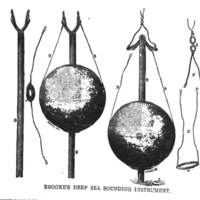"Brooke's Deep Sea Sounding Instrument & Core-Sampling Device"
Title
"Brooke's Deep Sea Sounding Instrument & Core-Sampling Device"
Subject
Illustration
Description
The item I chose to be further analyzed in this issue was the illustration provided of “Brooke’s Deep Sea Sounding Instrument,” which was the device used on the cable of the Transatlantic Telegraph Cable in order to trade communication. This was quite the complicated procedure to properly connect cables from the US to Ireland and Newfoundland. The American sailor, engineer and scientist known as John Mercer Brooke had created this invention for the sole purpose of making the Atlantic Telegraph Company possible on the orders of American businessman Cyrus Field. The device he created was made in the form of a cannonball with a coated, hollow tube attached to the center. This creation was meant to attach to a very long cable that would sink to the lower sea floor and feasible enough to transmit an electric current at the distance of 1,600 miles underwater. He was even able to attach a “core-sampling device” which was meant to pick samples of material on the sea floor for various studies.
Brooke’s principle reason for creating this invention supposedly stemmed from him and his colleagues not being able to find out where the bottom of the ocean floor began. His invention ended up working perfectly for the circumstances since he was able to send the device at such a low level on the ocean floor that strong currents and storms could not affect the device from transmitting electricity. Brooke and others organized a plan for this procedure by using four ships that would transport the cables to two locations and drop them into the ocean in both the US, Valentia, Ireland and Trinity Bay, Newfoundland. These four ships used were named the Corgon, Niagard, Agamemnon and Valorous.
The article provided a depiction of how the procedure occurred onto something that Brooke’s called the “telegraphic plateau.” It displayed the ocean having an underwater mountain ridge where these ships aided the cable placement in both the US and Europe to ensure the electric current was functional. It even described the later occurrence of the ship Agamemnon being broad sided by rogue waves while laying the cable and ultimately was destroyed due to a storm in the ocean. The procedure was still completed and efficient nevertheless.
Brooke’s principle reason for creating this invention supposedly stemmed from him and his colleagues not being able to find out where the bottom of the ocean floor began. His invention ended up working perfectly for the circumstances since he was able to send the device at such a low level on the ocean floor that strong currents and storms could not affect the device from transmitting electricity. Brooke and others organized a plan for this procedure by using four ships that would transport the cables to two locations and drop them into the ocean in both the US, Valentia, Ireland and Trinity Bay, Newfoundland. These four ships used were named the Corgon, Niagard, Agamemnon and Valorous.
The article provided a depiction of how the procedure occurred onto something that Brooke’s called the “telegraphic plateau.” It displayed the ocean having an underwater mountain ridge where these ships aided the cable placement in both the US and Europe to ensure the electric current was functional. It even described the later occurrence of the ship Agamemnon being broad sided by rogue waves while laying the cable and ultimately was destroyed due to a storm in the ocean. The procedure was still completed and efficient nevertheless.
Creator
Harper's Weekly, Author Unknown
Source
Harper's Weekly: A Journal of Civilization, Volume 2, No. 87 [CORRECT CITATION NEEDED]
Publisher
Harper's Weekly
Date
August 28, 1858
Contributor
Evan Orfanos
Format
PDF
Type
Magazine
Files
Collection
Citation
Harper's Weekly, Author Unknown, “"Brooke's Deep Sea Sounding Instrument & Core-Sampling Device",” Three Decades of NYC, accessed December 13, 2025, http://www.loyolanotredamelib.org/en203/items/show/20.

